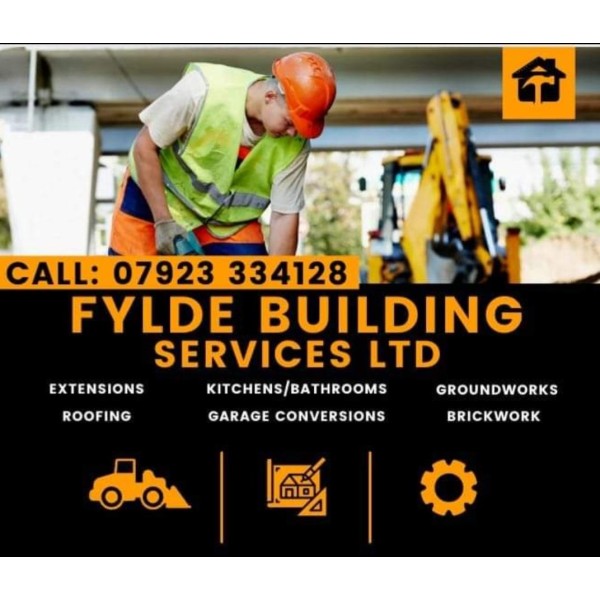Garage Conversions in Preston
Welcome to Brandon Green Homes T/a Renovaserve Ltd, your trusted partner for all your buildin... read more »
Welcome to Fylde Building Services, your go-to experts for all your building and renovation needs in Fleetwood and across Lancashire. As... read more »
Welcome to DPF Joinery, your premier choice for builders, carpenters, roofers, renovations, joiners, extension builders, loft conversions... read more »
Welcome to Argo Consultants Ltd, your go-to experts for builders, extension builders, and architectural services in Fleetwood, Lancashire... read more »
Welcome to Elevate Construction Group Ltd, your trusted partner for all your building needs in Leyland and throu... read more »
Welcome to Fylde Brickwork Ltd, your trusted partner... read more »
Welcome to Hall's Home Improvements and Renovations L... read more »
Welcome to Affordable Home Improvements, your trusted... read more »
Welcome to S W Joinery Building & Roofing, your go-to... read more »
Welcome to Barra Projects, your premier choic... read more »
Welcome to Scriven Construction and Engineering Ltd,... read more »
Phil Marlow Builders is a renowned b... read more »
Smedley Construction Ltd is your go-... read more »
Welcome to All Construction, your go-to experts for a... read more »
Welcome to Northern Construction And Civils, the prem... read more »
Welcome to Will Roofing and Home Maintenance, your go... read more »
Welcome to Helix Building Services Ltd, your go-to ex... read more »
Welcome to Complete Construction North West Ltd, your... read more »
Bricking It Ltd is a premier buildin... read more »
Search Garage Conversions in places nearby
- Garage Conversions in Lancaster
- Garage Conversions in Accrington
- Garage Conversions in Adlington
- Garage Conversions in Bacup
- Garage Conversions in Bamber Bridge
- Garage Conversions in Barnoldswick
- Garage Conversions in Barrowford
- Garage Conversions in Blackburn
- Garage Conversions in Blackpool
- Garage Conversions in Brierfield
- Garage Conversions in Burnley
- Garage Conversions in Carnforth
- Garage Conversions in Chorley
- Garage Conversions in Church
- Garage Conversions in Clayton-Le-Moors
- Garage Conversions in Cleveleys
- Garage Conversions in Clitheroe
- Garage Conversions in Colne
- Garage Conversions in Darwen
- Garage Conversions in Earby
- Garage Conversions in Fleetwood
- Garage Conversions in Freckleton
- Garage Conversions in Fulwood
- Garage Conversions in Great Harwood
- Garage Conversions in Haslingden
- Garage Conversions in Heysham
- Garage Conversions in Kirkham
- Garage Conversions in Leyland
- Garage Conversions in Longridge
- Garage Conversions in Lytham St Anne's
- Garage Conversions in Morecambe
- Garage Conversions in Nelson
- Garage Conversions in Ormskirk
- Garage Conversions in Oswaldtwistle
- Garage Conversions in Padiham
- Garage Conversions in Poulton-Le-Fylde
- Garage Conversions in Rawtenstall
- Garage Conversions in Rishton
- Garage Conversions in Skelmersdale
- Garage Conversions in Thornton
- Garage Conversions in Trawden
- Garage Conversions in Whitworth
Understanding Garage Conversions in Preston
Garage conversions in Preston have become increasingly popular as homeowners seek to maximise their living space without the hassle of moving. This trend is not only practical but also adds significant value to properties. By transforming an underutilised garage into a functional room, residents can enjoy a new office, bedroom, or even a gym. Let's delve into the various aspects of garage conversions, exploring the benefits, planning requirements, and creative ideas to inspire your project.
The Benefits of Garage Conversions
Garage conversions offer numerous advantages, making them an attractive option for many homeowners. Firstly, they provide additional living space without the need for an extension, which can be costly and time-consuming. Moreover, converting a garage is often more affordable than building an extension, as the structure already exists.
Another significant benefit is the potential increase in property value. A well-executed conversion can add up to 20% to the value of a home, making it a wise investment. Additionally, garage conversions are versatile, allowing homeowners to tailor the space to their specific needs, whether it's a home office, playroom, or guest suite.
Planning Permission and Building Regulations
Before embarking on a garage conversion in Preston, it's crucial to understand the planning permission and building regulations involved. In many cases, planning permission is not required, especially if the work is internal and does not alter the building's appearance. However, it's always wise to check with the local council to ensure compliance.
Building regulations, on the other hand, are mandatory. These regulations ensure that the conversion meets safety and energy efficiency standards. Key areas to consider include structural integrity, fire safety, insulation, and ventilation. Hiring a professional builder or architect can help navigate these requirements and ensure a smooth process.
Cost Considerations
The cost of a garage conversion in Preston can vary significantly depending on the project's scope and the quality of materials used. On average, homeowners can expect to spend between £5,000 and £15,000. Factors influencing the cost include the size of the garage, the complexity of the design, and any additional features such as plumbing or electrical work.
It's essential to set a realistic budget and obtain quotes from multiple contractors to ensure competitive pricing. Additionally, consider any potential hidden costs, such as planning fees or unexpected structural issues, which could impact the overall budget.
Design Ideas for Garage Conversions
When it comes to garage conversions, the possibilities are endless. The key is to identify your needs and design a space that complements your lifestyle. Here are some popular ideas:
- Home Office: With remote work on the rise, a dedicated home office can provide a quiet and productive environment.
- Guest Suite: Transform your garage into a comfortable guest suite, complete with a bedroom and en-suite bathroom.
- Playroom: Create a safe and fun space for children to play and explore.
- Home Gym: Avoid gym memberships by setting up a personal fitness area with all the necessary equipment.
- Art Studio: Unleash your creativity with a dedicated space for painting, crafting, or other artistic pursuits.
Choosing the Right Professionals
Hiring the right professionals is crucial to the success of your garage conversion. Look for builders or architects with experience in similar projects and check their references and credentials. A reputable professional will provide a detailed quote, timeline, and outline of the work involved.
Additionally, consider working with an interior designer to maximise the space's potential and ensure a cohesive design. Their expertise can help you choose the right colours, materials, and furnishings to create a functional and aesthetically pleasing environment.
Maximising Space and Functionality
One of the main goals of a garage conversion is to maximise space and functionality. Start by assessing the layout and identifying any potential challenges, such as low ceilings or limited natural light. Clever design solutions, such as built-in storage, multi-functional furniture, and strategic lighting, can help overcome these obstacles.
Consider incorporating open-plan designs to create a sense of spaciousness and flow. Additionally, use mirrors and light colours to enhance the feeling of space and make the room feel larger than it is.
Insulation and Energy Efficiency
Insulation is a critical aspect of any garage conversion, ensuring the space is comfortable and energy-efficient. Proper insulation will help regulate temperature, reduce energy bills, and prevent dampness. Key areas to insulate include walls, floors, and ceilings.
Consider using energy-efficient windows and doors to further enhance insulation and reduce heat loss. Additionally, installing energy-efficient lighting and heating systems can contribute to a more sustainable and cost-effective conversion.
Addressing Structural Concerns
Before commencing a garage conversion, it's essential to address any structural concerns. This may involve reinforcing walls, floors, or ceilings to ensure the space is safe and stable. A structural engineer can assess the garage's condition and recommend any necessary modifications.
Additionally, consider the garage's foundation and drainage systems, as these can impact the conversion's success. Proper drainage is crucial to prevent water ingress and potential damage to the new living space.
Incorporating Natural Light
Natural light can significantly enhance the appeal and functionality of a converted garage. Consider installing windows or skylights to bring in more light and create a bright, welcoming environment. If privacy is a concern, frosted glass or strategically placed blinds can provide a solution.
Additionally, use reflective surfaces, such as mirrors or glossy finishes, to bounce light around the room and create a sense of openness. Thoughtful lighting design, including layered lighting and dimmable fixtures, can further enhance the space's ambience.
Flooring Options for Garage Conversions
Choosing the right flooring is an important consideration for any garage conversion. The flooring should be durable, easy to maintain, and suitable for the intended use of the space. Popular options include laminate, vinyl, carpet, and engineered wood.
Consider the room's function when selecting flooring. For example, a home gym may require rubber flooring for shock absorption, while a guest suite may benefit from the warmth and comfort of carpet. Additionally, ensure the flooring is compatible with any underfloor heating systems you plan to install.
Heating and Ventilation Solutions
Proper heating and ventilation are essential for creating a comfortable and healthy living environment. Consider installing a central heating system or electric radiators to provide consistent warmth. Underfloor heating is another popular option, offering efficient and even heat distribution.
Ventilation is equally important, helping to prevent dampness and improve air quality. Options include extractor fans, trickle vents, or mechanical ventilation systems. Ensure the chosen solution is suitable for the space and complies with building regulations.
Decorating Your Converted Garage
Once the structural work is complete, it's time to focus on decorating your converted garage. Choose a colour scheme that complements the rest of your home and reflects the room's purpose. Neutral tones can create a calming atmosphere, while bold colours can add personality and vibrancy.
Incorporate personal touches, such as artwork, photographs, or decorative accessories, to make the space feel inviting and unique. Additionally, consider the room's layout and furniture placement to ensure a functional and aesthetically pleasing design.
Security Considerations
Security is an important consideration for any garage conversion, particularly if the space will be used as a living area. Ensure all windows and doors are secure and fitted with appropriate locks. Consider installing a security system or CCTV for added peace of mind.
Additionally, ensure the garage's exterior is well-lit to deter potential intruders. Motion-sensor lights or smart lighting systems can provide effective security solutions without compromising energy efficiency.
Legal and Financial Implications
Before proceeding with a garage conversion, it's essential to understand the legal and financial implications. This includes any potential impact on your mortgage, insurance, or property taxes. Consult with your mortgage provider and insurance company to ensure compliance and avoid any unexpected issues.
Additionally, consider the potential return on investment and how the conversion may affect your property's value. A well-executed conversion can enhance your home's appeal and marketability, making it a worthwhile investment.
Frequently Asked Questions
- Do I need planning permission for a garage conversion in Preston? In most cases, planning permission is not required, but it's best to check with the local council.
- How long does a garage conversion take? The timeline can vary, but most conversions take between 4 to 6 weeks to complete.
- Can I convert a detached garage? Yes, detached garages can be converted, but additional considerations, such as access and utilities, may be required.
- Will a garage conversion add value to my home? Yes, a well-executed conversion can increase your property's value by up to 20%.
- What are the building regulations for garage conversions? Building regulations cover areas such as structural integrity, fire safety, insulation, and ventilation.
- Can I do a garage conversion myself? While DIY is possible, hiring professionals ensures compliance with regulations and a high-quality finish.
In conclusion, garage conversions in Preston offer a practical and cost-effective solution for homeowners looking to expand their living space. By understanding the planning requirements, costs, and design possibilities, you can create a functional and stylish addition to your home that meets your needs and enhances your property's value.
Send a message









